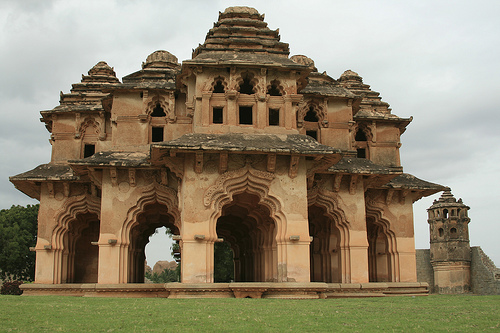Hampi is a UNESCO World Heritage Site on the southern bank of the Tungabhadra river in the Vijayanagara district of Karnataka. It is a sheer delight for travellers, who have an eye for history and religion. The ancient ruins of the historic village of Hampi, which spreads over 4,100 hectares, are remnants of the glorious past and still strike wonder in people who visit the place.

The History of Hampi
Hampi was a fortified city and the capital of the Vijayanagara empire in the 14th century. Hampi in 1500 CE had the glory of being the world’s second largest city after Beijing. It was a flourishing city, drawing traders from Persia and Portugal. It has been recorded in the chronicles by the Persian, European travellers, particularly the Portuguese that Hampi on the banks of the Tungabhadra river in those days spelt prosperity with many temples, farms and trade markets.
The monuments of the Vijayanagara city were constructed between 1336-1570 AD from the times of Harihara-I to Sadasiva Raya. Krishnadevaraya also contributed in the way of royal buildings from 1509 to 30 AD. The structures boast of Dravidian architecture. However, in 1565, the muslim sultanates conquered Hampi and brought its ruin. Though the place is pillaged and is in ruins, the beautiful natural setting of Hampi, which comprises the River Tungabhadra and the boulders are present to this day.

Hampi today – Places to visit in Hampi
Hampi is an archeological wonder and famous for its beautiful monuments, though in ruins that are remnants of the glorious past. UNESCO describes Hampi as an “austere, grandiose site” boasting of “forts, riverside features, royal and sacred complexes, temples, shrines, pillared halls, mandapas, memorial structures, water structures, stables etc. Large dimensions, florid ornamentation, bold and delicate carvings, stately pillars, magnificent pavilions are characteristics of the temples of Hampi, depicting scenes from the Ramayana and the Mahabharata.
- Of these, the Krishna temple complex, Narasimha, Ganesa, Hemakuta group of temples, Achyutaraya temple complex, Vitthala temple complex, Pattabhirama temple complex, Lotus Mahal complex etc are worth the mention.
- The Virupaksha temple, also referred to as the Pampapathi temple is beautifully renovated, maintaining its old charm and is now in worship. It is the oldest shrine and the most important destination for tourists and pilgrims.
- The Vittala temple is a splendid depiction of the Vijayanagara style of architecture.
- Hazara Ramachandra temple, Chandrasekhara temple, the Krishna temple, Pattabhirama temple, Jaina temples are also other examples of beauty and grace.
- The Queen’s palace and the Lotus-Mahal within the Zenana enclosure depict the magnificent anthapura.
- The Dhananayaka’s enclosure (treasury), Mahanavami Dibba, the elephant’s stables, pillared mandapas and numerous ponds and lakes still speak of the erstwhile glory of Hampi.
- There has also been recent excavations of palatial complexes, a large number of stone images, beautiful terracotta objects, stucco figures, a square stepped-tank (Sarovara) at the south-west of Mahanavami Dibba, Buddhist sculptures of 2nd -3rd century AD etc.
- The Archaeological museum is a home to antiques and great sculptures.
- The underground Shiva temple is one of the oldest temples in Hampi, dedicated to Lord Shiva. Most parts of this temple remain submerged in water because it was built several meters below the ground level.
- The Yantrodharaka Hanuman temple, also called the Monkey temple, believed to be the birthplace of Lord Hanuman situated on a hillock, is also worth the visit in Hampi.
- Bellary, Anegundi and Kamalapur near Hampi have historical value and attract a lot of tourists.

Best time to visit Hampi
The best time to visit Hampi is from October to February during Winter, favourable for exploring the place except in the warm afternoons. The monsoon season from July to September is also an ideal time to visit Hampi with less rain, yet rendering a vibrant green look to its surroundings. Summer from March to June is generally very hot and is not the ideal time to visit Hampi.
How to reach Hampi
By Air
Hubli Airport, which is about 170 km from the historic site of Hampi is the nearest airport and tourists can avail cabs in the airport to reach Hampi.
By Train
The Hospet junction is the nearest and well-connected railway station to Hampi, which is around 13 km. From here, one can avail a cab to reach Hampi. This is one of the preferred modes of transport to Hampi.
By Road
Hampi is well connected by road to the rest of the places in Karnataka. Apart from the Karnataka State Road Transport Corporation (KSRTC), private buses and also interstate buses ply regularly from the neighbouring cities and towns. Bus travel from Bangalore to Hampi takes less than 8 hours. Tourists can also drive to Hampi via NH13 route from Hyderabad (375 km), Bangalore (341 km) and Hubli (167 km).
Also see
- In Kannada: ಹಂಪಿ: ಕಲೆ- ಧರ್ಮ -ಸಂಸ್ಕೃತಿಗಳ ಸಮ್ಮಿಲನ
- Top 5 Things to Do in Hampi
- Top 15 sites in Hampi to visit
- 10 Less Known Facts about Hampi
- Akka Tangi Gudda – A Wonder Formed by Rock
- Ancient Bridge
- Chakratirtha – The Sacred Swirl of Water
- Dasara Dibba or Mahanavami Dibba
- Domed Gateway
- Gejjala Mantapa
- Granaries – Remnants of Ancient Storages
- Hampi Festival
- Hampi Bazaar
- Hotels in Hampi
- King’s Audience Hall
- King’s Balance
- Kuduregombe Mantapa
- Temples
- Rock Climbing
- Pan Supari Bazaar
- Pushkaranis – The Sacred Water Tanks of the Ancient Times
- Royal Enclosure – The Ruined Grandeur of Royalty
- Tenali Rama Pavilion
- Vira Harihara Palace